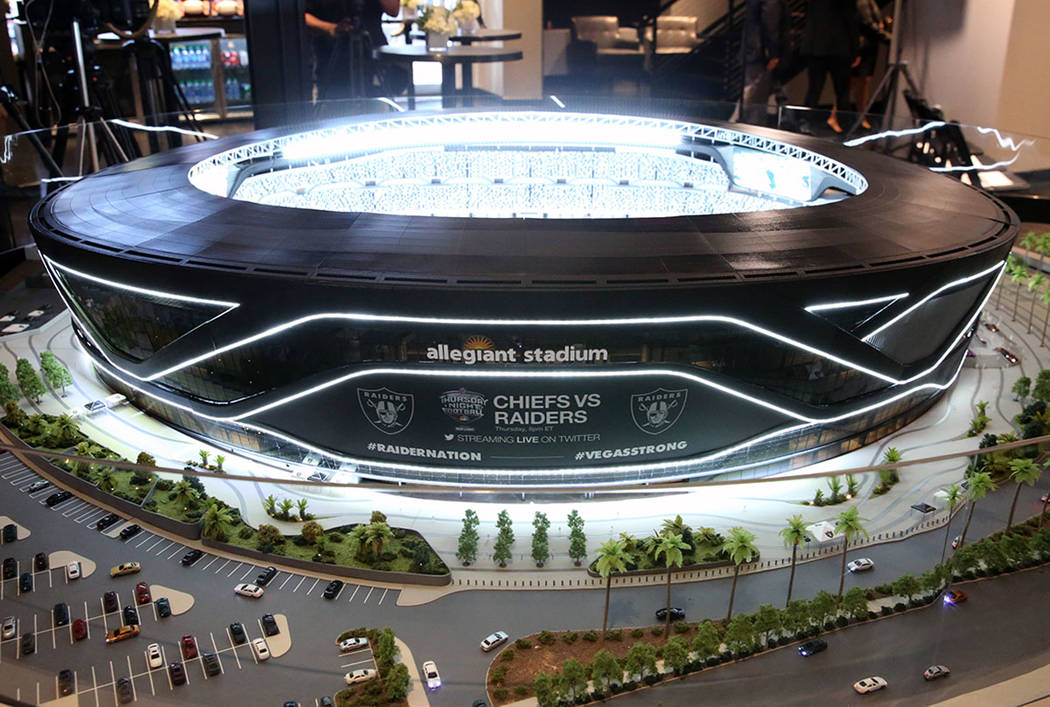Conspiracy theories abound on Allegiant Stadium construction, scheduling

Enough with the conspiracy theories.
Two different stories last week about the construction of Allegiant Stadium and the scheduling of the first events at the 65,000-seat, $2 billion venue created a firestorm of criticism from just about everyone associated with the project.
Some of it came from well-meaning outsiders genuinely concerned about the project, the safety of workers and fans, as well as the success of UNLV’s transition from Sam Boyd Stadium to Allegiant. But I’d say more of it came from people still bitter about:
A) the Raiders moving from Oakland to Las Vegas;
B) the deal Gov. Brian Sandoval and the Nevada Legislature made to contribute $750 million in public money to the project;
or C) where the stadium sits on policymakers’ priority list relative to education, health care or other state issues.
Instead of assessing the hows and whys involving the challenging installation of Allegiant Stadium’s translucent roof, some critics preferred to blame the Raiders for installing faulty bolts from China to attach the roof and dreaming up doomsday scenarios of a deadly collapse.
The scheduling story involved UNLV’s nonconference 2020 football season and when the first games are to be played at the stadium. Some blamed UNLV for scheduling games beyond its agreed-upon allotment, while others pointed fingers at the Raiders for hogging the new venue.
Instead of getting riled up about busted bolts and placing blame on schedulers, everyone needs to take a step back, chill and look at solutions.
The back story on bolting the cable grid to the top of the stadium is that during the attachment process, eight of 560,000 bolts failed because they were overstressed by the pull of those cables. Some misinterpreted that as workers placing too much torque on bolts during installation.
Regardless, stadium construction company chief operating officer Don Webb ordered a metallurgical analysis of the broken bolts and found none of them to be substandard. He added that none of those bolts came from China, as theorized by critics.
While some have speculated that the roof attachment process has stopped as a result of the broken bolts, the reality is that final attachment has been resequenced as work continues on the stadium’s ground level. The project remains on schedule with substantial completion by July 31.
Incidentally, “substantial completion” means not every aspect of the stadium will be done — just enough so that crowds can enter and games can be played. That’s what matters most to fans — that the Raiders and UNLV will be able to play their games in the stadium.
The scheduling matter is the other controversy but similarly solvable.
Under the agreement signed by the Raiders and the Nevada Board of Regents on March 27, 2018, the UNLV football team is allowed to play two nonconference games in the stadium per season. The problem is UNLV signed deals to play the University of California and Arizona State University at home in 2020 well before the stadium agreement was signed. A third game, against Louisiana Tech, also was signed. It’s common practice to schedule nonconference games years in advance.
This appears to be nothing more than UNLV scheduling as it should, well in advance, and then a legitimate business decision to provide access to two nonconference games in addition to the four Mountain West games likely to be played each season — six home dates, the normal number of games one would expect for a college football team.
The problem seems to be that the stadium, as a brand new venue, is more popular than expected — it’s a new special-events venue for large concerts and events bound to boost Las Vegas as a destination.
Who wouldn’t want a local performance with the likes of the Rolling Stones, U2 or Bruce Springsteen?
The Raiders are acting on their responsibility to fill the building with events that will attract visitors from across the country. September happens to be a prime time for such events, and the newness of Allegiant Stadium is contributing to its immediate popularity. But three games are on the tentative schedule when just two are allowed.
It should also be noted that the Raiders made a huge concession in the development of Allegiant’s early scheduling. The Cal game is scheduled Aug. 29, which means UNLV would play the first football game in the new stadium and not the Raiders.
Fortunately, there’s a prescribed solution to resolving the matter. The Raiders can meet with UNLV to come up with some proposed solutions. Ultimately, the Las Vegas Stadium Authority must approve stadium scheduling, so if there are unresolved issues, it could be called upon to weigh in.
Board members certainly want what’s best for UNLV and the Raiders and, most importantly, the community.
Contact Richard N. Velotta at rvelotta@reviewjournal.com or 702-477-3893. Follow @RickVelotta on Twitter.